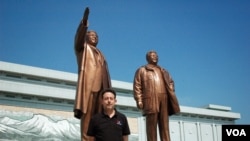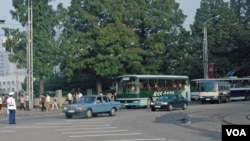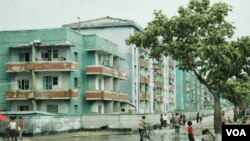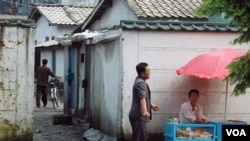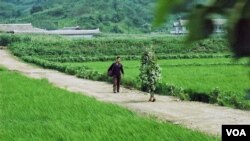For reporters, some parts of the world are simply impenetrable. High on that list is North Korea, one of the most reclusive and politically isolated countries in the world.
VOA Asia Correspondent Steve Herman was able to get inside for nine days.
Herman was allowed entry to report on 88-year-Thomas Hudner, an American war veteran, who returned to North Korea hoping to recover the remains of his wingman, whose aircraft crash landed during a fierce Korean War battle 63 years ago. Hudner was unable to complete his mission due to serious flooding in the region.
And Steve, accompanied by North Korean escorts, got a rare look at Pyongyang and other areas. We spoke to him in Tokyo, shortly after his trip to find out what it was like.
VOA: Steve, you have just returned from a nine-day-long trip to North Korea. That in and of itself is a rather newsy thing to do.
Herman: "Well obviously you never really can understand a place until you’ve been there, and we’ve had a tiny bit of glimpse by being able to spend time not only in Pyongyang, but also to get out to some of the rural areas, places other foreign correspondents have not been able to go, nor are on the typical tours offered to Westerners."
"Also, our route was altered a little bit when we left Pyongyang due to the serious flooding, so we were on some alternate roads that we were not intended to be traveling on. And we saw some things that the typical foreigners going into the DPRK, the Democratic People’s Republic of Korea, do not see, such as how people in the rural areas live, which is obviously quite a contrast from the presentation of central Pyongyang, which has high-rise buildings, where the electricity stays on most of the time – at least while we were there – and has fancy restaurants, even a few outside the hotels, and such activities as bowling alleys and all the major tourist attractions, most of them tied to the glorifying the state and its leaders past and present."
VOA: Describe what it felt like to be in the capital versus all the years you’re spent in Seoul. Are these really two different Koreas? And also, a little bit about what these rural areas are like.
Herman: "Pyongyang obviously cannot rival Seoul. Seoul is one of the most developed cities in the world, and Pyongyang is nowhere near that. That said, Pyongyang does have high-rise buildings. It does have traffic, not as much as Seoul or any even much smaller cities we might find in Asia or Europe. And there were no overt signs of poverty or anyone starving in the capital. Everyone looked fairly well-fed and well-dressed. But once you get to the outskirts of the city, and especially into the rural areas, that view changes very quickly."
"We got into two areas in the North of Pyongyang. One was a city called Hyangsan which has some tourist attractions nearby. And [one] in the general vicinity called Kujang, where we saw much different scenes than in Pyongyong.
The apartment buildings were much more dilapidated. The main mode of transport for people who were not on foot was on bicycle. We saw people pushing carts, pulling carts, carts being driven by oxes.
"We also saw what maybe be a little bit of entrepreneurship, or capital enterprise, going on in the streets of these small cities, where people set up stalls on the roadside, selling food.
Another was a young lady sitting under a red umbrella and had a blue box in which she was selling what appeared to be some sort of bread and drinks out of it."
"We were not allowed to stop and talk to any of these people. The other thing that you really notice, both in the city and the countryside, is the pervasiveness of the military and military vehicles. We saw a lot of not only soldiers riding in the backs of military trucks to get around. Some of these may be on work detail because there was quite serious flooding while we were there. And we saw these propaganda loudspeaker trucks going around, calling people out in the recovery effort in the flooding."
VOA: You never spoke to any ordinary North Korean citizens, is that correct?
Herman: "We did have interaction with people in Pyongyang that we came up to in some of the tourism sites. These were impromptu encounters, so I have no evidence whatsoever that anything was staged."
"Also, we did meet in [the] countryside and interact with tour guides…we could ask the tour guides anything we wanted. But we did not stop in the areas that I would have liked to stop in the countryside and talk to the farmers. We saw quite an abundance of crops….we saw fields and fields of corn, rice and, at least in this area that we were in, the harvest this year looked it was going to be quite bountiful."
Soundslide from VOA's Steve Herman from North Korea
VOA Asia Correspondent Steve Herman was able to get inside for nine days.
Herman was allowed entry to report on 88-year-Thomas Hudner, an American war veteran, who returned to North Korea hoping to recover the remains of his wingman, whose aircraft crash landed during a fierce Korean War battle 63 years ago. Hudner was unable to complete his mission due to serious flooding in the region.
And Steve, accompanied by North Korean escorts, got a rare look at Pyongyang and other areas. We spoke to him in Tokyo, shortly after his trip to find out what it was like.
VOA: Steve, you have just returned from a nine-day-long trip to North Korea. That in and of itself is a rather newsy thing to do.
Herman: "Well obviously you never really can understand a place until you’ve been there, and we’ve had a tiny bit of glimpse by being able to spend time not only in Pyongyang, but also to get out to some of the rural areas, places other foreign correspondents have not been able to go, nor are on the typical tours offered to Westerners."
"Also, our route was altered a little bit when we left Pyongyang due to the serious flooding, so we were on some alternate roads that we were not intended to be traveling on. And we saw some things that the typical foreigners going into the DPRK, the Democratic People’s Republic of Korea, do not see, such as how people in the rural areas live, which is obviously quite a contrast from the presentation of central Pyongyang, which has high-rise buildings, where the electricity stays on most of the time – at least while we were there – and has fancy restaurants, even a few outside the hotels, and such activities as bowling alleys and all the major tourist attractions, most of them tied to the glorifying the state and its leaders past and present."
VOA: Describe what it felt like to be in the capital versus all the years you’re spent in Seoul. Are these really two different Koreas? And also, a little bit about what these rural areas are like.
Herman: "Pyongyang obviously cannot rival Seoul. Seoul is one of the most developed cities in the world, and Pyongyang is nowhere near that. That said, Pyongyang does have high-rise buildings. It does have traffic, not as much as Seoul or any even much smaller cities we might find in Asia or Europe. And there were no overt signs of poverty or anyone starving in the capital. Everyone looked fairly well-fed and well-dressed. But once you get to the outskirts of the city, and especially into the rural areas, that view changes very quickly."
"We got into two areas in the North of Pyongyang. One was a city called Hyangsan which has some tourist attractions nearby. And [one] in the general vicinity called Kujang, where we saw much different scenes than in Pyongyong.
The apartment buildings were much more dilapidated. The main mode of transport for people who were not on foot was on bicycle. We saw people pushing carts, pulling carts, carts being driven by oxes.
"We also saw what maybe be a little bit of entrepreneurship, or capital enterprise, going on in the streets of these small cities, where people set up stalls on the roadside, selling food.
Another was a young lady sitting under a red umbrella and had a blue box in which she was selling what appeared to be some sort of bread and drinks out of it."
"We were not allowed to stop and talk to any of these people. The other thing that you really notice, both in the city and the countryside, is the pervasiveness of the military and military vehicles. We saw a lot of not only soldiers riding in the backs of military trucks to get around. Some of these may be on work detail because there was quite serious flooding while we were there. And we saw these propaganda loudspeaker trucks going around, calling people out in the recovery effort in the flooding."
VOA: You never spoke to any ordinary North Korean citizens, is that correct?
Herman: "We did have interaction with people in Pyongyang that we came up to in some of the tourism sites. These were impromptu encounters, so I have no evidence whatsoever that anything was staged."
"Also, we did meet in [the] countryside and interact with tour guides…we could ask the tour guides anything we wanted. But we did not stop in the areas that I would have liked to stop in the countryside and talk to the farmers. We saw quite an abundance of crops….we saw fields and fields of corn, rice and, at least in this area that we were in, the harvest this year looked it was going to be quite bountiful."
Soundslide from VOA's Steve Herman from North Korea





